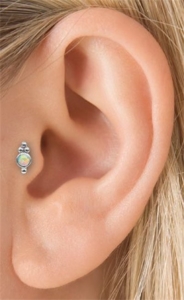Contents
Tragus Piercing – What is this type of piercing?
What is a Tragus Piercing?
A tragus piercing is a piercing that is pierced by the thicker cartilage part of the ear, at the entrance of the auditory canal – see our ear guide here for more on the areas of the ear.
Just like a helix piercing, it became very fashionable in the 1990s and is still popular.
Process of Piercing the Tragus
First of all, you should be aware that the piercing is a so-called cartilage piercing, which is more difficult to pierce than a typical piercing in the earlobe. The healing of a tragus piercing could take much longer. Nevertheless, the Tragus Piercing is one of the more common type of piercings, so it is offered by almost every piercing studio and professional piercer.
After the piercer has informed you about the risks and the process and you have signed that you’re happy to go ahead, the piercing can take place in what should be a very sterile environment. Before the canal is pierced, the area around the inlet and outlet is thoroughly cleaned and disinfected. Now the place is marked with a pen so you can check in its positioning.
The tragus piercing spot is engraved with a specially developed piercing cannula. This is a tube, which is hollow from the inside, so that the piercer can push through, and which remains when pulling out of the cannula in the freshly pierced channel and which can now be carefully closed. Behind the tragus, a piece of cork should be held against to prevent injuries in the ear canal. Since the cartilage tissue in Tragus piercing is very well supplied with blood, it often starts to bleed, which is completely normal and not uncommon.
Healing and Care of Tragus Piercings
The healing process of a tragus piercing can be from two months to eight months. The first few days you should not wear tight caps, as this would exert too much pressure on the fresh and healing piercing. The sea or the swimming pool should be avoided due to the chlorine and salt content as well as bacteria present, which can lead to severe inflammation of the fresh piercing.
For care, which is very important, it is not recommended to use alcohol-based disinfectants. For cleaning, you usually get a small vial from the piercer or give it to you in the pharmacy. Gently apply the remedy to a clean cotton swab and gently clean the area around the puncture and exit points. Thus, the encrustations can be gently soaked and then removed, without parts of the wound are torn open again.
The disinfection and cleaning of the piercing must be done at least twice a day, and of course, until this is completely healed. In addition, it is important to gently rotate the piercing every day so that it does not grow together with the healing tissue. The after piercing must remain in the piercing channel until complete healing and may only then be replaced by a normal piercing. Shortening should be done by the piercer, if at all. The piercer is also the right person to contact if there are problems with piercing, if there are still questions or if the pain does not subside even after several days.
Material and models
For the tragus piercing 316L Surgical Steel or Titanium is mostly used. These materials are considered very robust and high quality, so that it is tolerated by the body usually without problems. As for jewellery, use a Ball Closure Ring (BCR) or a labret plug is recommended. The after piercing, however, often consists of plastic. It is important to pay attention to the thickness of the rod so that the tragus is not unnecessarily squeezed. Too thick a piercing would have the dilation of the channel result and too thin a rod causes the piercing channel would gradually reduce.


Share this entry